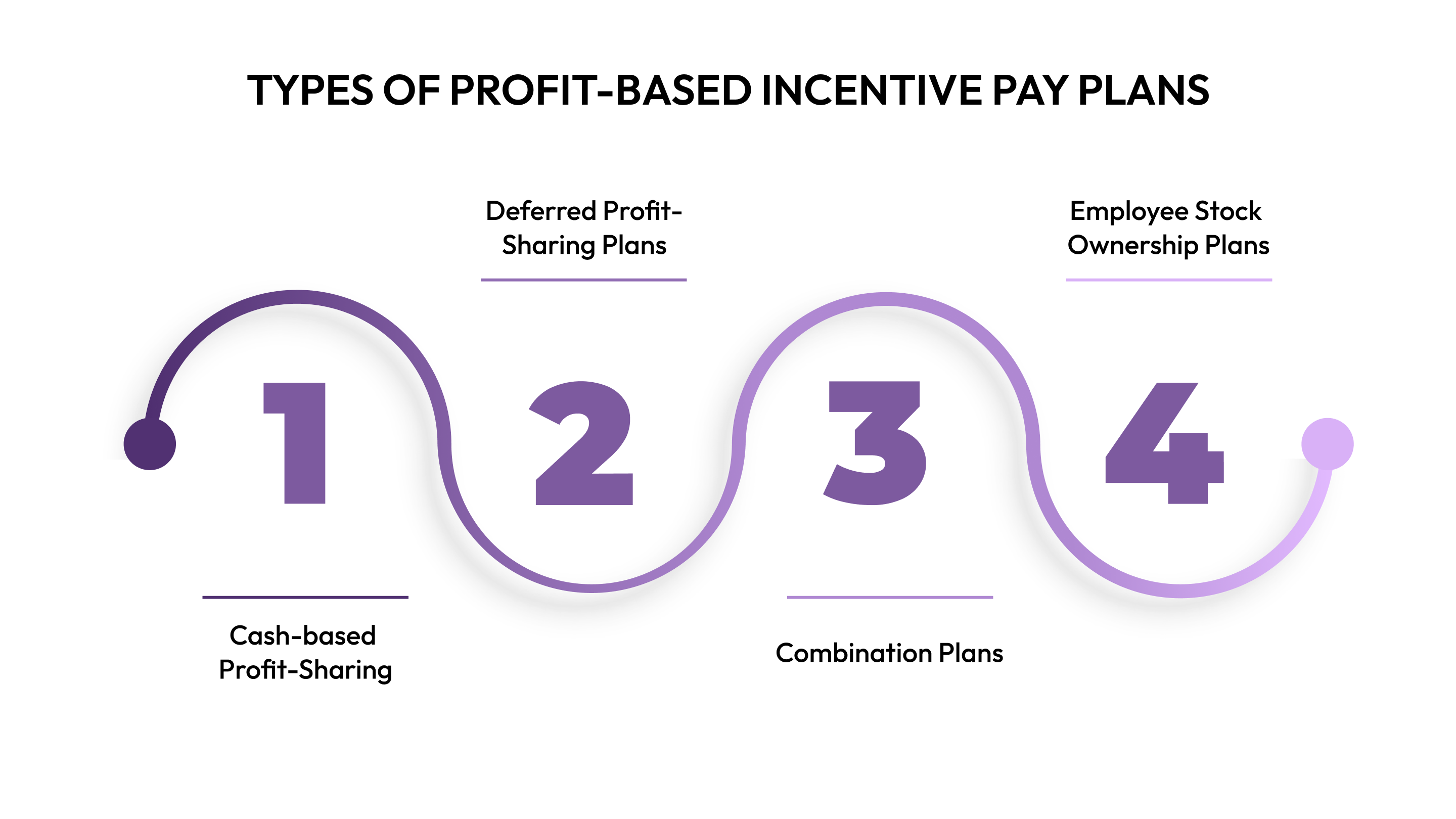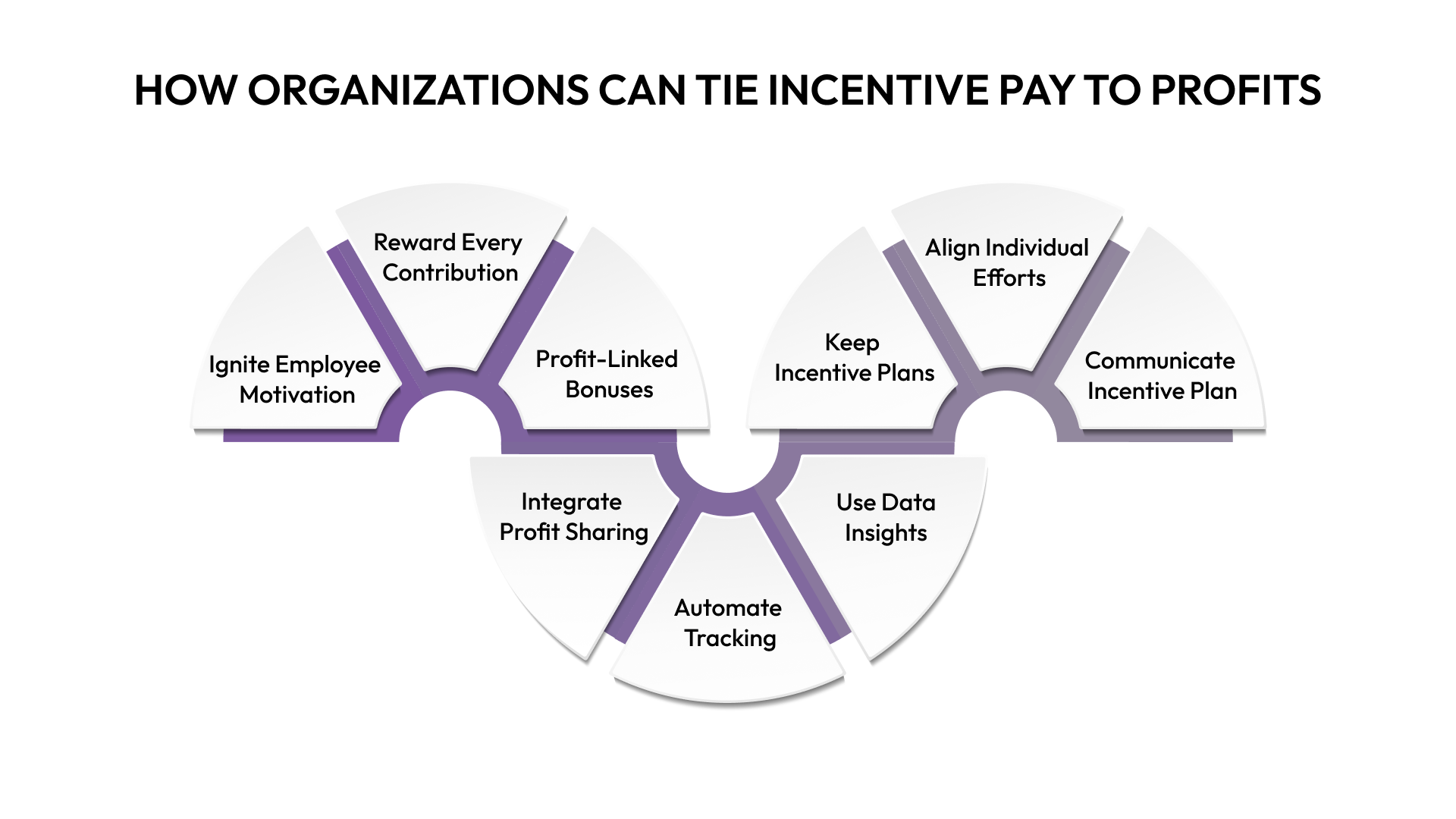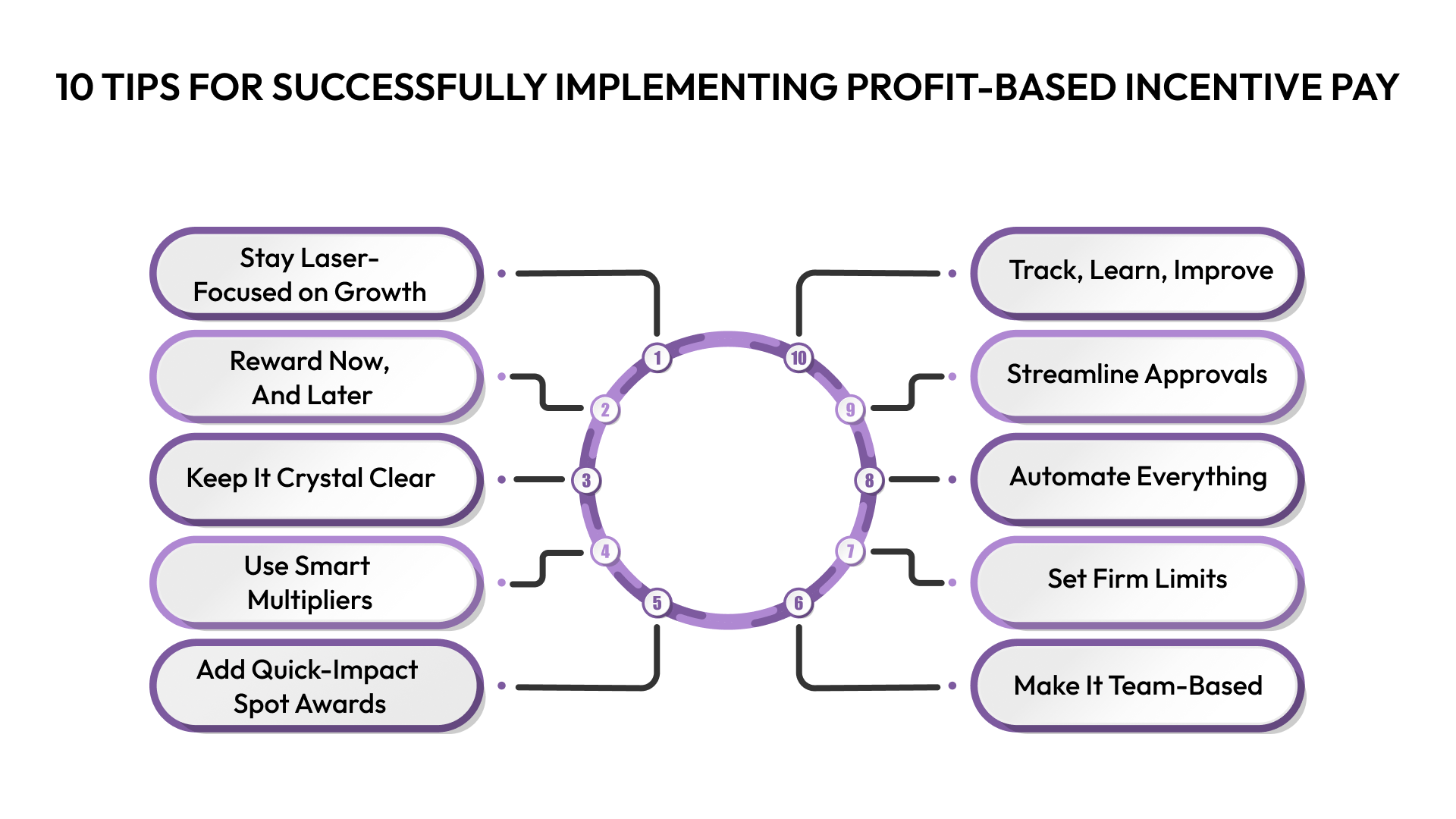Strategies for Tying Incentive Pay to Profits
Learn how an organization can tie incentive pay to profits effectively, driving motivation and aligning employee goals with business success.

Imagine a mid-sized company on the brink of explosive growth, with a lean HR and finance team struggling to keep compensation plans in sync with rapidly growing profits. McKinsey’s research shows that companies linking incentive pay to profits saw nearly a fivefold increase in total shareholder returns compared to those that didn’t.
Yet, despite these impressive results, only two-thirds of organizations connect financial incentives to transformation or measurable business outcomes during times of major change. This leaves a huge untapped opportunity for scaling businesses.
For CPOs, CFOs, and People Ops leaders, discovering how an organization can tie incentive pay to profits is no longer just a strategic move; it’s essential for fueling growth. In this blog, we’ll explore powerful strategies to turn your compensation plans into profit-driven motivators that spark employee engagement and drive sustainable success.
At a glance
- Companies linking incentive pay to profits see 5x higher shareholder returns, yet only two-thirds actually do it during major transformations.
- Profit-based incentive pay works by distributing a percentage of company profits to employees through cash bonuses, deferred plans, stock options, or hybrid models.
- Four main types exist: cash-based profit-sharing (immediate rewards), deferred plans (retirement-focused), combination plans (both), and ESOPs (ownership stakes).
- Nine core strategies include setting clear profit metrics, tailoring incentives by role, automating tracking systems, and maintaining transparent communication.
- Implementation success depends on balancing short and long-term rewards, keeping plans simple, using data to optimize, and establishing firm budget controls.
- Automation is non-negotiable for scaling companies; manual spreadsheets create bottlenecks that slow growth and increase errors.
- The right structure aligns everyone: when employees see how their work impacts profits and their paycheck, engagement and retention dramatically improve.
How Incentive Pay Linked to Profits Works
Incentive pay, often referred to as profit sharing, rewards employees based on the company’s overall financial success, rather than individual or departmental performance.
How It Works
This strategy aligns employees' interests with the company's success, making them feel more invested in the business’s overall performance.
- Profit-sharing works like a bonus system. Once the company’s profits are calculated (typically on a quarterly or annual basis), a percentage is allocated to employees.
- The total pool can be distributed equally or based on factors like role, tenure, or salary.
- For example, if a company makes $10 million in profit and shares 2%, $200,000 is set aside as profit. How it’s split depends on the company's formula, which could be equal or based on position.
Distribution Methods
Profit-sharing plans also vary in how the profits are distributed:
- Pro-rata: The company allocates profit proportionally based on each employee’s salary.
- Same-dollar or Flat-dollar: Every eligible employee receives the same amount.
- Age-weighted: Older employees get a larger share to support retirement savings.
- New Comparability: Different employee groups, like executives versus staff, receive varying contribution rates while complying with nondiscrimination rules.
In short, profit-linked incentive pay links rewards to a company's success. When done right, it fosters motivation, loyalty, and a shared sense of achievement.
Now let's explore the different structures you can choose from to match your organization's unique needs.
Types of Profit-based Incentive Pay Plans

Profit-based incentive pay plans come in various forms, each with different payout structures and objectives. Here are the major types of profit-based incentive plans:
- Cash-based Profit-Sharing: Employees receive cash bonuses directly tied to the company’s profits, usually paid annually or quarterly. These bonuses are taxed as income and offer immediate rewards for the company’s performance.
- Deferred Profit-Sharing Plans: The company allocates profit shares to employees’ retirement accounts, which can only be accessed upon retirement or departure. This approach provides tax advantages and encourages long-term employee retention.
- Combination Plans: This model blends immediate cash payouts with deferred retirement contributions, offering employees both instant rewards and long-term benefits.
- Employee Stock Ownership Plans (ESOPs): Instead of cash, employees receive shares in the company, aligning their interests with the company’s success and fostering a sense of ownership.
With these foundational concepts in place, let's move from theory to practice. Here are nine proven strategies to effectively tie incentive pay to your company's profits.
How Organizations Can Tie Incentive Pay to Profits

If you are a growth-stage organization managing distributed teams and seeking to improve budget governance and streamline workflows, tying incentive pay to profits can be highly effective when done strategically.
Here are some actionable strategies suited for you:
1. Set Clear, Profit-Driven Metrics to Ignite Employee Motivation
For businesses on the rise, defining clear, measurable profit-based metrics is crucial. Align compensation with specific, achievable business goals, whether it’s revenue growth, cost control, or profitability targets. When employees understand the connection between their performance and company profits, they gain a sense of ownership in driving success.
2. Tailor Incentives to Roles: Reward Every Contribution
Not all roles influence profits in the same way. Implement tiered incentive structures tailored to different roles. For example, sales teams might be rewarded for hitting sales targets and generating revenue, while support or operations teams can focus on efficiency and cost-saving goals. This ensures everyone feels valued and sees how their efforts contribute to the bottom line.
3. Shift from Fixed Salaries to Profit-Linked Bonuses
Instead of relying solely on fixed salaries, introduce profit-based bonuses. This way, employees’ rewards grow in tandem with the company’s success, a powerful tool for businesses with limited resources or those in high-growth stages. To streamline this process, CandorIQ’s Compensation Cycle allows businesses to automate bonus and merit reviews, ensuring efficiency while tying compensation to company results.
4. Integrate Profit Sharing Programs to Foster a Sense of Ownership
Profit-sharing programs allow employees to directly benefit from the company’s success. When employees receive a share of profits, it fosters a sense of ownership, aligning their success with the company’s growth.
For example, Yotascale, a cloud cost management platform, transformed its compensation approach by implementing structured bonus and incentive programs. This reduced their compensation cycle time by 75%, all while ensuring fairness and transparency.
Their success shows that profit-sharing is not just about money, but about building scalable systems that grow with your business.
5. Automate Tracking and Optimize Your Incentive Pay Systems
As companies scale, tracking incentive pay manually becomes increasingly inefficient. Invest in automation tools or HR software that links performance metrics with compensation tracking. This reduces errors, saves HR and finance teams time, and ensures that employees are compensated fairly based on their contributions to profits.

6. Use Data Insights to Fine-Tune Your Incentive Plans
Performance pay management becomes exponentially more effective when backed by solid data. Leveraging analytics for performance-based incentives can ensure your compensation decisions are strategic, not just reactive. CandorIQ’s AI Agent provides real-time compensation recommendations based on historical benchmarks, making it easier to adjust incentive plans for optimal performance.
7. Keep Incentive Plans Simple, Transparent, and Easy to Understand
Simplicity is key when designing incentive pay plans. Make sure the criteria for earning rewards are straightforward and easily understood by all employees. Clear communication eliminates confusion, ensuring that everyone knows what targets they need to hit to earn their incentives.
8. Align Individual Efforts with Company-Wide Goals
Link individual goals directly to company-wide profitability. When employees see how their performance directly impacts the company’s success, they become more motivated to contribute to its growth. This alignment creates a shared sense of responsibility and drives higher performance across the organization.
9. Keep Employees in the Loop: Communicate Incentive Plan Changes
As your business evolves, so should your incentive plans. Regularly communicate any changes to employees and ensure they understand how updates will affect their potential rewards. Open lines of communication help maintain motivation and keep everyone aligned with the company’s goals.
Strategy is only half the battle. Successful execution requires tactical wisdom gained from experience. Here are ten battle-tested tips to ensure your profit-based incentive program delivers real results.
Need help identifying which metrics work best? Our guide on creating effective employee incentive plans walks through selecting the right performance indicators for different business stages.
10 Tips for Successfully Implementing Profit-Based Incentive Pay

Implementing profit-based incentive pay isn't just about choosing the right structure; it's about executing with precision. These practical tips will help you avoid common pitfalls and maximize the impact of your compensation strategy.
- Stay Laser-Focused on Growth: Tie bonuses to high-impact metrics, profit, revenue, or retention. When teams see, their work directly drives their own rewards, engagement soars.
- Reward Now, And Later: Mix instant cash bonuses with long-term incentives (like stock options or deferred plans). Short-term wins fire up fast results, while promises for tomorrow keep top talent loyal.
- Keep It Crystal Clear: Incentive plans should be easy to grasp and share. A transparent formula plus a predictable payout calendar means less confusion and fewer roadblocks, especially for remote teams.
- Use Smart Multipliers: For budget control, introduce accelerators (bonus bump for spectacular profits) and decelerators (cap payouts during tight times). This keeps finance teams smiling and incentives powerful.
- Add Quick-Impact Spot Awards: Recognize superstar effort on the fly with small, non-cash rewards. This is a surefire way to reinforce good habits and keep energy high, without breaking the budget.
- Make It Team-Based: Share success across groups, not just individuals. A team-profit approach builds cross-functional trust and means everyone roots for overall growth. While profit-sharing focuses on company-wide success, don't overlook other employee incentive ideas that boost day-to-day engagement and complement your profit-based programs.
- Set Firm Limits: Create incentive pools as a slice of projected profits. Run scenarios to see what payouts look like; this gives CFOs control with no budget surprises.
- Automate Everything: Ditch spreadsheet chaos. Use compensation management software to centralize tracking, automate workflows, and unleash crystal-clear analytics in real time.
- Streamline Approvals: Put compensation workflows under one digital roof, instant approvals, swift payments, and clean audit trails. Distributed teams love the speed, and leadership loves the visibility.
- Track, Learn, Improve: With dashboards and analytics, monitor what works. Adjust metrics and payouts as the business grows; never stay stuck with yesterday’s plan.
Understanding how bonuses fit within your broader compensation strategy is essential. Explore how total rewards programs integrate with incentive structures to achieve maximum impact.
Conclusion
Tying incentive pay to profits turns compensation into a growth driver. Aligning rewards with business outcomes fosters a culture where everyone shares in success and feels invested in the company's future. The key is simplicity, transparency, and the right tools to scale.
For growing companies with distributed teams, manual processes can quickly become bottlenecks. CandorIQ streamlines this by automating merit cycles and using AI-powered benchmarking, freeing you to focus on strategic decisions rather than spreadsheets.
Ready to optimize your compensation strategy and fuel sustainable growth? Book a demo today and see how we make profit-linked pay seamless and practical.
Frequently Asked Questions
1. How do I measure the success of my incentive pay program?
Measure success by tracking key metrics such as employee productivity, retention rates, and overall company profitability. If your incentive program is well-aligned, you should see improvements in these areas as your team works towards common profit-driven goals.
2. Can remote teams be effectively incentivized the same way as in-office employees?
Absolutely. The key is to ensure that remote teams have clear performance metrics tied to company goals. You can design tiered incentive systems or use technology to track remote performance and align it with business outcomes.
3. How can I ensure my incentive pay program stays within budget while still motivating employees?
Set clear thresholds for incentive payouts and use data to predict and manage your payouts. Incorporating automation tools can help track and control compensation within your budget while adjusting incentives as needed.


